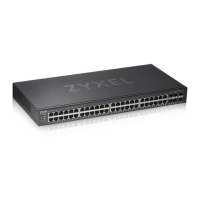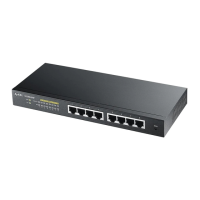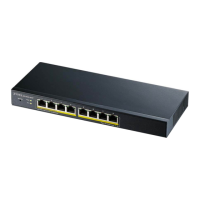GS1920 Series User’s Guide
119
CHAPTER 13
Spanning Tree Protocol
13.1 Spanning Tree Protocol Overview
The Switch supports Spanning Tree Protocol (STP), Rapid Spanning Tree Protocol (RSTP) and
Multiple Spanning Tree Protocol (MSTP) as defined in the following standards.
• IEEE 802.1D Spanning Tree Protocol
• IEEE 802.1w Rapid Spanning Tree Protocol
• IEEE 802.1s Multiple Spanning Tree Protocol
The Switch also allows you to set up multiple STP configurations (or trees). Ports can then be
assigned to the trees.
13.1.1 What You Can Do
•Use the Spanning Tree Protocol Status screen (Section 13.2 on page 122) to view the STP
status in the different STP modes (RSTP, MRSTP or MSTP) you can configure on the Switch.
•Use the Spanning Tree Configuration screen (Section 13.3 on page 122) to activate one of the
STP modes on the Switch.
•Use the Rapid Spanning Tree Protocol screen (Section 13.4 on page 123) to configure RSTP
settings.
•Use the Rapid Spanning Tree Protocol Status screen (Section 13.5 on page 125) to view the
RSTP status .
•Use the Multiple Rapid Spanning Tree Protocol screen (Section 13.6 on page 126) to
configure MRSTP.
•Use the Multiple Rapid Spanning Tree Protocol Status screen (Section 13.7 on page 128) to
view the MRSTP status.
•Use the Multiple Spanning Tree Protocol screen (Section 13.8 on page 130) to configure
MSTP.
•Use the Multiple Spanning Tree Protocol Status screen (Section 13.9 on page 135) to view
the MSTP status.
13.1.2 What You Need to Know
Read on for concepts on STP that can help you configure the screens in this chapter.
(Rapid) Spanning Tree Protocol
(R)STP detects and breaks network loops and provides backup links between switches, bridges or
routers. It allows a switch to interact with other (R)STP -compliant switches in your network to
ensure that only one path exists between any two stations on the network.

